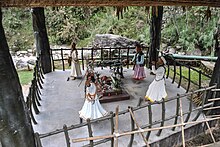Jhākri



Jhākri (
Indian states of Sikkim and West Bengal, which border Nepal. The practice of using a Jhaakri as a channel or medium by a Hindu god or goddess to give solutions or answers to the questions of devotees is known as, "dhaamee (Nepali
: धामी)" in Nepali.
Jhākri shamanism or dhaamee is practiced among numerous
Some vernacular words form jhākri are phedangbo in the Limbu language, Nakchhong, Mangpa/Bijuwa in Rai, and boongthing in Lepcha.Jhākris perform rituals during weddings, funerals, and harvests. They diagnose and cure diseases. They are also known for performing a form of voluntary spirit possession, whereby they allow the supposed spirit of the dead to possess them for a brief time thereby allowing family members to communicate for a brief period of time. The practice is called "Chinta". Their practices are influenced by
Bön rites.[3]
Mostly, Jhakri use pray items like dhyāngro, a traditional frame drum made up of animal leather banded in a hallow wood on both side, bells connected by rope. They use Mantra in Tibetan language or their own native language.
See also
- Banjhakri and Banjhakrini, shaman deities of Nepal
- Banjhakri Falls and Energy Park, a tourist attraction in Northeast India, with statues of jhākri
Notes
- ^ Gulia 2005, pp. 153–4
- ^ Gulia 2005, p. 152
- ^ Gulia 2005, p. 168
References
- Gulia, Kuldip Singh (2005). Human Ecology of Sikkim: A Case Study of Upper Rangit Basin. ISBN 81-7835-325-3.
